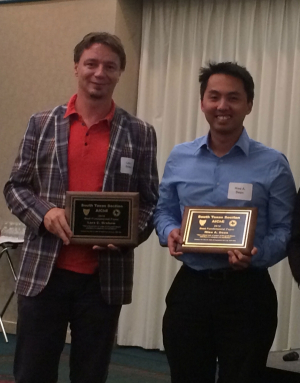Last year, a professor and student in the chemical and biomolecular engineering department at the UH Cullen College of Engineering published an article in Science outlining a surprising discovery about gold’s unexpected catalytic properties. Their paper, which was the first to ever fully explain what happens during the catalytic oxidation of carbon monoxide, has now been chosen as Best Fundamental Paper of 2014 by the South Texas Section (STS) of the American Institute of Chemical Engineers (AIChE).
Assistant professor Lars Grabow conducted this research alongside his Ph.D. student, Hieu Doan. Their collaborators on this project were Bert Chandler, Johnny Saavedra, and Christopher Pursell at Trinity University in San Antonio. The award was announced at a ceremony held on Oct. 1 at the 7th Southwest Process Technology Conference in Galveston, Texas.
One of the most desirable qualities of gold is its ability to resist rusting and tarnishing thanks to its inertness – that is to say, it’s lack of reactivity with other substances. However, gold nanoparticles have long been used as catalysts to oxidize carbon monoxide (CO) into carbon dioxide (CO2).
For over 25 years, researchers have observed the catalytic behaviors of gold and proposed many explanations as to why an inert metal would help to speed up a chemical reaction. Before Grabow and Doan conducted this research, no single model has completely explained what takes place during a reaction wherein gold is used to help transform CO into CO2.
Using the best available experimental and theoretical methods in combination, the team was able to provide direct evidence of the role each element plays in this particular chemical reaction, and proposed a novel reaction mechanism that addresses long-standing questions.
“The answer is water,” Grabow said. Although water is not one of the reactants in this chemical reaction, Grabow’s team was able to prove that it serves as a co-catalyst for the reaction.
But if water isn’t intentionally added to the chemical reaction, how does it get there in the first place? “Well, water is everywhere,” Grabow said. “It’s in the air and we know it as humidity. More importantly, it’s in pretty much every chemical reactor that we’re operating unless it’s inside of an ultra-high vacuum, of course.”
The presence of tiny amounts of water is what essentially drives the reaction on the surface of the gold catalysts. A thin layer of water, approximately 2 molecular layers, settles on the surface of the catalyst, and protons (positively charged hydrogen atoms) from inside the water layer can detach from the water molecules and attach themselves to oxygen molecules. Those protonated oxygen molecules are then absorbed onto the surface of the gold catalyst, allowing the reaction to proceed very quickly. When the reaction is complete, the protons return once again to the water layer on the surface of the catalyst.
“We imagine that the layer of water is like a sea of protons. Protons swim in that water layer like fish, they jump out to facilitate the reaction and then they jump back into the water layer,” Grabow said.
Doan ran calculations to determine the role each element plays in the oxidation of carbon monoxide. Once completed, Doan used this data to create a novel model to describe precisely what is happening in the reaction.
“I came up with a model to describe what’s happening in this reaction so we can visualize all of the elements of the catalyst and bring them together in a scientific way,” he said.
The Best Fundamental Paper Award has given by the STS section of AIChE each year since 1959. STS is the largest local section of AIChE, the world’s largest organization for chemical engineering professionals.
To access the Science article, please visit https://dx.doi.org/10.1126/science.1256018
